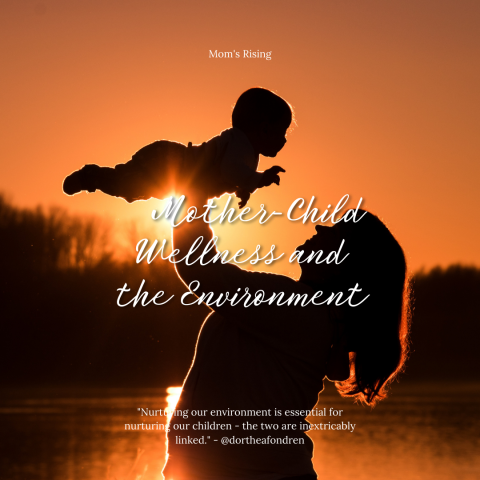
credit: social media image created by @dortheafondren
Uncovering the Link Between Mother-Child Wellness and the Environment
Due to the global pandemic, the importance of a holistic approach to health and wellness that takes into consideration both individual well-being and environmental systems has become increasingly apparent. Nowhere is this more pronounced than in the case of mothers and children, who are particularly vulnerable to any disruptions in their environment. Integrating the well-being of mothers and children with environmental systems is essential for providing mental health outcomes that can be sustained over time.
Mental health support for mothers and children often focuses solely on individual-level interventions. This approach, however, ignores the fundamental influence that environmental factors have on an individual’s well-being. Research shows that social determinants including access to healthy foods, clean air, clean water, poverty, access to healthcare services, housing security, and quality of education all play a role in shaping an individual’s current state of being as well as future opportunities for success.
As a mother of color, the environment affects me and my children in unique ways. Beyond the physical health risks that come with living in an urban area where air pollution or contaminated water is more common than clean air and water, our mental health and well-being are also at risk. Mothers of color face a disproportionate number of environmental challenges due to their location near industrial sites, transportation corridors, hazardous waste facilities and more. These health disparities can lead to higher rates of depression, anxiety, and stress within our communities which then has an effect on the overall development of children growing up in these environments.
The eco-wellness concept can help mothers of color better understand how our environment impacts us on a larger scale. This concept looks at how activities related to nature or being outdoors can improve mental as well as physical well-being for both adults and children alike.
As a mother, I wanted to ensure that my children had the best possible chance at living a healthy and happy life. I realized that this could only be achieved if I took action to improve not only their lives but also our community as a whole.
When I started my journey toward creating a healthier environment for my children and community members as an Organizer, there were various areas of environmental and climate justice that needed to be addressed. First and foremost was mental health: it is essential for both individuals and communities to have access to resources like therapy, activities, and social support networks in order to thrive. Additionally, eco-friendly practices such as recycling and reducing electricity usage were important steps towards creating an environmentally conscious lifestyle. Furthermore, developing an understanding of nutrition led me down the path of preparing nutritious meals with fresh produce from local farmers' markets - something that has since become part of our regular routine.
How does integrating individual well-being with environmental systems help children?
There is a great deal of research to suggest that environmental systems can benefit children in many ways. One such way is by providing a safe and healthy home for the family or having access to good nutrition, clean air, and water. Another way is by providing a healthy environment for the child to grow up in. But integrating individual well-being with environmental systems is not only beneficial for children. There are many ways that integrating individual well-being can help mothers.
How does it help mothers?
Here are some ways that environmental systems and having access to healthy communities can help mothers and children:
- - It helps mothers to have a healthier environment for their babies to grow in.
- - It helps mothers feel less stressed and more relaxed.
- - It helps mothers and children have more time to spend together.
- - It helps mothers and children have a better quality of life.
- - It helps mothers and children have more time to do other things.
- - It helps mothers and children feel more connected.
- - It helps mothers and children have a better quality of sleep.
- - It helps mothers and children have more time to bond.
- - It helps mothers and children have more time to connect.
- - It helps mothers and children have more time to be creative.
- - It helps mothers and children have more time to be productive.
- - It helps mothers and children have more time to enjoy life.
How does it help the environment?
The way that individual well-being is looked at in the United States is a bit different than in other countries. In the United States, individual well-being is usually looked at as a social concern. This means that the aim is to make sure that every individual has the ability to reach their full potential and make a difference in society. In other countries, individual well-being is looked at as an environmental concern. This means that the aim is to help the earth in order to make it a better place. This is often accomplished through projects that focus on the environment.
The human body is an integral part of the earth’s ecology. The average person has a lot of impact on the environment, such as through the air they breathe, the water they drink, and the food they eat. However, there is another part of the human body that is hugely impacted by the environment: the mother’s body and the baby’s body. The mother’s and baby’s bodies are reliant on the environment because the Earth provides the nutrients that the earth needs to thrive.
In conclusion, there is a strong link between mother-child wellness and the environment. For many families, the home is not only a sanctuary for physical comfort but also an emotional haven for well-being. The quality of the internal and external environment has been identified as having an impact on mothers’ mental health and capacity to provide nurturing care to their children.
This connection has led to research exploring how improvements in the ecosystem can benefit both parents and children alike. Studies have shown that investments in clean air and water initiatives, green spaces, renewable energy sources, sustainable agriculture practices, and other environmental improvements have resulted in improved maternal mental health which translates into more positive outcomes for their children’s overall development.
The implications of this evident – environmental interventions can be used as preventative measures against poor long-term health and well-being outcomes for both mothers and their children.



The views and opinions expressed in this post are those of the author(s) and do not necessarily reflect those of MomsRising.org.
MomsRising.org strongly encourages our readers to post comments in response to blog posts. We value diversity of opinions and perspectives. Our goals for this space are to be educational, thought-provoking, and respectful. So we actively moderate comments and we reserve the right to edit or remove comments that undermine these goals. Thanks!